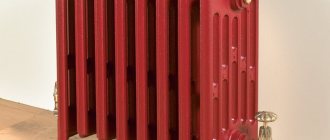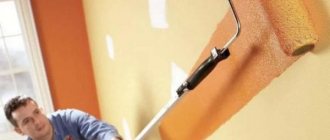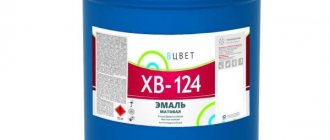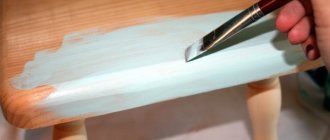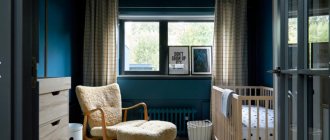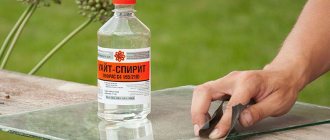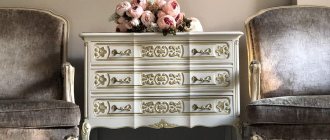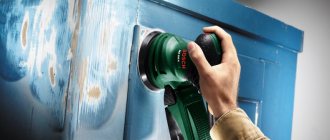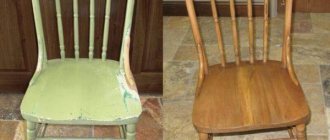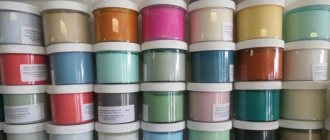Acrylic water-dispersion paint is high-quality and durable, easy to apply to the surface. It is used by craftsmen at industrial facilities. The paint is water-based and contains small particles of acrylate resin.
On the left is acrylic universal water-dispersion paint from Ceresit, on the right is acrylic moisture-resistant water-dispersion paint for walls and ceilings from Yaroslavl paints.
Advantages of acrylic polymer dispersions
Acrylic water-dispersion paint performs a decorative function and protects walls and ceilings.
Advantages of paint:
- Good adhesion. The material is applied to brick, concrete and wooden surfaces.
- Waterproof. Once dry, it creates a durable coating that can be washed with soap.
- Correct application of the coating guarantees a service life of 10-20 years.
- The sun's rays do not destroy the top layer, the shade does not fade.
- No toxic substances are added during the production process.
- No pungent odor. The solution is safe for health.
- The material is elastic, resistant to impacts and external factors.
- The film can “breathe”, so fungus and mold do not appear on the walls.
An additional advantage is the use of paint in various areas of production and industry. It dyes textiles very well. Artists design decorative objects, images and portraits on canvas.
Acrylic water-dispersion paints are quickly applied and dry within 60-120 minutes.
Product cost
It is best to purchase acrylate compounds in specialized construction stores or trusted chain stores.
Buying paint on the market may result in a poor-quality coating obtained as a result of improper storage of the mixture or failure to meet the end date of use. The price of water-dispersed acrylic paint varies from 150 to 1000 rubles/l or more. The cost is influenced by the popularity of the manufacturer and the performance characteristics of the mixture. The most expensive paints are characterized by high durability and color saturation.
Advice: to reduce the cost of purchasing paint and varnish products, you should purchase paint in larger containers. A correctly calculated amount of material will allow you to avoid overpayments and minimize unspent balances.
Main operating parameters
The main operational parameters include color, appearance of the surface after application, the proportion of resin content, and additional components.
Main paint properties and technical characteristics:
- after application and hardening, a homogeneous film with a smooth surface is formed;
- the selected shade will be similar to the sample in the catalog;
- slightly alkaline composition;
- titanium dioxide is added to the composition;
- drying speed in warm weather – 60 minutes;
- After complete drying, the surface of the walls and ceilings can be washed.
The properties of the paint include its resistance to frost. It refers to the number of freezing cycles that the coating can withstand under standard conditions. Additional parameters are drying speed, resistance to light and mechanical damage.
How to paint walls or ceilings with acrylic paint
If you decide to do the painting yourself, but do not have the technique of a master, you should familiarize yourself in detail with the procedure for performing the work and the properties that acrylic enamel paint has. This modern material is used to create different interior styles, including Art Deco, which is characterized by high aesthetics and luxury. The colors of acrylic paints from the San Marco brand make it possible to emphasize interior features by selecting the desired tone. At the same time, the material will protect the walls from the appearance of mold and mildew.
To ensure good adhesion, the base is carefully prepared:
- you need to clean and wash off the old coating;
- apply putty, sand it;
- get rid of dust;
- apply primer.
Prepare the composition of the required thickness. The paint thinner is water. The ceiling is processed first. The correct execution of further steps involves painting it in one go, so that the acrylic paint does not dry out and its transition is not visible. This can be attributed to the disadvantage of this material.
Correctly selected, high-quality tools play an important role:
- special bath;
- rollers;
- tassels;
- sponge.
Types of water-dispersion paints
White matte versatate acrylic water-dispersion paint under the FacadePaint trademark.
There are 5 options for water-dispersion paint on the construction market. They differ from each other in their connecting components.
Types of VDK:
- With the addition of polyvinyl acetate. Paint can be damaged by moisture. During operation, the surface acquires a yellow tint. The composition contains PVA glue, so an elastic and durable film is formed. The paint can be used for interior work.
- Butadiene-styrene dispersion. This is a waterproof material. After application and drying, an airtight film is formed. Paint deteriorates when exposed to sunlight. The surface can be washed with water. It will last a long time with proper care and use, because the protective layer is deformed during an impact.
- Styrene This paint is more expensive, but it has increased weather resistance. The material is porous, vapor-permeable, and has the ability to adhere to different surfaces. After application to the walls, a durable film is formed.
- Versatate dispersion. This is a versatile and expensive material. It does not deform under mechanical loads and is resistant to ultraviolet rays. On this basis, high-quality material is made that can be applied to wood, concrete and other surfaces . Even under unfavorable conditions, the coating will last up to 25 years if the production and application technology has been followed.
Each of these types of paints can last up to 20 years under normal conditions.
Main differences or what is the difference
Having considered all the characteristics, we can conclude that water-based paints differ from water-dispersion paints. It is worth noting that water is only 1 part by which these compositions can be equated, otherwise there are only differences:
- One of the main things to highlight is the excellent moisture resistance of water-dispersed ones, but water-emulsion ones are very easy to wash off with water. It is better not to use it for painting damp rooms.
- Water-based dyes have a good hiding power.
- Water-based dyes are significantly cheaper than the comparable competitor.
- To dilute water-based paint, use plain water; for water-based paint, it is better to use a solvent, such as white spirit.
- Water-dispersed is often produced in white and use color to add color.
Our expert advises reading this:
- Choosing a yacht varnish for woodworking Initially intended as an external and internal impregnation of wooden ship hulls, yacht varnish has now become actively used in…
- How to get red by mixing paints Everyone knows that by combining 3 primary colors (red, yellow and blue), you can achieve any other color. This theory is still in...
- Polyvinyl acetate water-based paints - characteristics and composition Preparing for alterations in the apartment, we come to the problem of selecting paint, thanks to which our design thoughts will come to life. She should fit...
Application methods
When performing repairs or construction work, it is important to follow the technological process and the method of applying the layer.
Craftsmen can use the following tools depending on the chosen method:
- brush;
- simple or textured roller;
- applying paint using a spray gun with a compressor connected.
Manufacturers use water as a base, so it is important to follow the technological process.
Rules for applying material to the surface:
- The optimal air temperature for work is at least +5°C. Sometimes manufacturers provide additional instructions on the packaging.
- Do not apply paint to a wet or damp surface. The base must be sanded, without gloss or residues of other coloring materials.
- It is recommended to use painting tools that are resistant to corrosion. After work, they are thoroughly washed and dried.
- During application, try not to spill the paint. Once dry, it is difficult to remove from the surface.
- Painted products can be used after 2-3 days, when the material is completely dry. The final drying time is at least 5 days.
Manufacturers allow craftsmen to dilute the paint with water. The amount of liquid should not exceed 5% of the total weight.
Basic tool for applying acrylic paint.
Consumption of materials
An important indicator when carrying out painting work is the amount of paint required to apply to 1 m2 of surface.
A little less commonly used is the area value, for which 1 liter of paint is enough to paint. An important property of a paint composition is hiding power - the ability of a coating to hide the color of the surface on which it is applied. The consumption of water-dispersed acrylic paint indicated on the container is valid for maximum coverage, at which the parameters of the previous layer and its presence will not be noticeable.
The costs of water-dispersed acrylic paints are usually from 120 to 150 g/m2. This figure is not final and depends on the properties of the material being processed (smooth, rough, absorbs or does not absorb solvent, etc.). A number of paints to impart special wear-resistant qualities must be applied in quantities increased to 200 g/m2.
To pre-calculate how much paint will be required for a specific amount of work, the consumption indicated by the manufacturer should be multiplied by 1.15. In this way, you can be guaranteed to avoid searching for paint of an identical color if the quantity purchased is not enough.
Acrylic VDK for external use
To organize work outdoors, you must wait for favorable weather conditions.
When applying a layer of acrylic VDK, it is important to follow the following rules:
- High humidity levels contribute to the destruction of the coating. After application, a protective layer will not appear, so the paint will not be able to dry completely.
- Work is not carried out in windy weather. There is a possibility of sand or small debris sticking to it.
- Exposure to direct sunlight will cause paint to set unevenly. During hot periods, it is recommended to create artificial shading. It will be easier for the master to work, defects during application can be avoided, and drips can be removed.
Acrylic paint must be applied according to the instructions.
Sequence of work:
After cleaning, the facade must be primed with a specialized deep penetration compound.
- First, remove all stains and dirt from the surface. It is recommended to use a degreaser.
- All irregularities are leveled out. You can use putty, cement-sand mortar, and plastering the walls.
- Areas with mold are treated with rags and removed with sandpaper. A fungicide is applied to problem areas.
- When painting for the first time, the walls are pre-primed with a roller or brush. The primer dries within 14 hours.
- The paint is thoroughly mixed before use. You can give the desired shade by adding color or mixing several pigments.
After hardening, the layer of material becomes durable and cannot be washed off. For personal safety, wear gloves or treat the skin with a thick cream.
Types of acrylic-based paints from San Marco
The range of acrylic paints from the Italian manufacturer San Marco is quite wide. The company produces interior paints (for interior work) and facade paints (for exterior work). San Marco produces innovative paints that meet modern requirements.
They fit well on the surface being treated, creating a uniform layer, and are characterized by long-term operation. You can choose glossy or matte paint that is impact-resistant, washable, moisture-resistant, high-performance, and at a cost that will fit your budget. All paints from this brand are of high quality.
Professional secrets for interior work
The paint can be used for indoor work, but the requirements must be followed. After covering the walls, the humidity level in the room increases. To quickly harden the layer, you need to install a fan.
To obtain an even coating, you must follow the following rules and recommendations:
To evenly cover a plastered façade, at least 3 layers of paint are required.
- application from top to bottom;
- first use a brush to paint over all hard-to-reach areas and irregularities;
- wait 4-5 hours between applying each layer;
- if the surface absorbs the material quickly and well, it is covered with 3-4 layers;
- before work, the plinths are removed;
- If you plan to paint the wall in several colors, you can use construction tape.
Ready-made stencils are intended for decorating walls. Recently, special rollers have appeared, the surface of which has a texture. They are used to create complex decorative elements.
Useful tips
If the water-dispersed paint has been standing for too long and has thickened, it is diluted with water. It is recommended to paint any surfaces at an air temperature of 8–30 ⁰С. If work is carried out outside, exposure to precipitation should be avoided. If paint gets on your hands, it can be easily washed off with warm water and soap.
You should not use this paint for surfaces that quickly become dirty. When dry, it acquires a certain roughness, which contributes to the rapid accumulation of dirt. This should be taken into account in cases where water-based wall paint is used.

